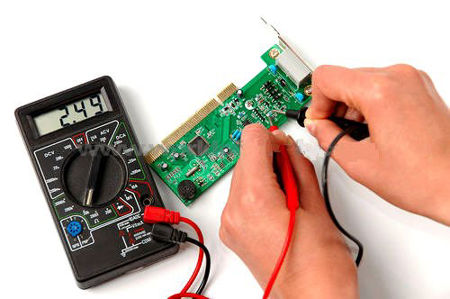Given we are talking about electronic components, caution should be used when testing them. Too many elements with the ability to cause serious harm have to be avoided or countered; and how and where they are tested should be thought about prior to the testing. Beyond electricity, heat is another aspect of some appliances’ use that needs to be addressed.
The first step in most testing procedures is turn off the power and disconnect it from the source. “Continuity testers work by sending a small current through the circuit, so the circuit needs to be disconnected from its power supply,” WikiHow notes.
While people recommend removing the component from the appliance it is being used on, prior to testing it. Many components already installed on a circuit board can, however, be tested while still on the circuit board. These circuit board components can be tested where they are, capacitors, resistors, transistors and integrated circuits are such components. Obviously, start by looking at the components on the board to see if they are in good condition - a broken component stops the appliance from working or builds up to a bigger problem.
“Knowing which parts are more likely to break or cause any of the most common problems helps you save time and means you only need to dismantle the appliance far enough to give you access to the likely culprit,” Fred’s Appliance Academy opines.
The Academy also notes a multimeter is a handy tool for testing continuity, voltage, and resistance. It can work testing both AC and DC voltages, and also test components still attached to the circuit board. There are three major things to test.
-
Continuity is the first thing to check. This tests if electricity can flow through the component.
-
Resistance is the next thing to test for. Here you are checking to see if there is current loss when electricity is flowing through the component. Ohms are the measurement here and this can become a complicated test. You need to manually set the expected range of loss, while making sure the expected voltage can be handled by the multimeter you are using.
-
Like the test for resistance, checking Voltage and the force of electric pressure requires a multimeter. Here you need to know if it is AC or DC current - a voltmeter can also be used here.
Continuity should be first, as it gives you the required baseline for testing resistance and voltage. Testing diodes can be done without the continuity, as they are one directional - thus “by measuring the resistance in both directions, it is possible to ascertain whether the diode is working, and also which connections are the anode and cathode,” Electronics Notes explains.
If you plan on testing numerous components, Instructables provides a build for a tester that can be used on virtually all non power components - the Component Tester.
Most electronic components can be tested using the 3 steps detailed above. The more complex components will be examined in a later article.
contact us:
 EN
EN
 English
English
 Chinese
Chinese
 Italiano
Italiano
 Portuguese
Portuguese
 Deutschland
Deutschland
 French
French
 Russian
Russian
 Japanese
Japanese
 Turkish
Turkish
 Korean
Korean
 Spanish
Spanish
 my account & orders
my account & orders

